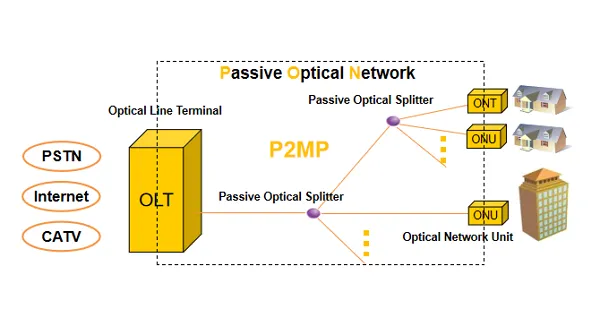What Are the Differences Between ONT, OLT, and ONU?

Optical Network Terminal (ONT)
Location: The ONT is located at the customer’s premises, such as a home or office.
Function: It serves as the endpoint of the PON on the user’s side. The ONT acts as an optical modem, converting optical signals received from the OLT into electrical signals that can be used by the customer’s devices.
Responsibilities:
Receives optical signals from the OLT and converts them into electrical signals for use by devices like computers, phones, and TVs.
Sends user data upstream to the OLT.
Provides interfaces for voice, video, and data services to the customer.
May include additional features such as Wi-Fi connectivity, VoIP support, and IPTV capabilities.
Optical Line Terminal (OLT)
Location: The OLT is located at the service provider’s central office or data center.
Function: It serves as the endpoint of the Passive Optical Network (PON) on the ISP’s side. The OLT aggregates and manages multiple Optical Network Terminals (ONTs) and Optical Network Units (ONUs) in the network.
Responsibilities:
Converts electrical signals from the service provider’s network into optical signals for transmission over the fiber optic network.
Manages the flow of data both upstream (from users to the ISP) and downstream (from the ISP to users).
Coordinates multiple analog or digital signals into one signal through multiplexing.
Ensures efficient network operation and manages bandwidth allocation and quality of service for all connected ONTs/ONUs.
Optical Network Unit (ONU)
Location: Similar to the ONT, the ONU is also located at the customer’s premises.
Function: The terms ONU and ONT are often used interchangeably, but there can be slight differences based on the context and specific network architecture.
Responsibilities:
Like the ONT, the ONU converts optical signals from the OLT into electrical signals for the customer’s devices.
It may serve multiple end-users in a multi-dwelling unit (MDU) or business complex, whereas an ONT typically serves a single user or household.
Performs functions such as signal modulation, demodulation, and data forwarding.
Conclusion:
OLT: Central device at the ISP’s office, managing and aggregating multiple ONTs/ONUs, converting signals, and controlling data flow.
ONT: Device at the customer’s premises, converting optical signals to electrical signals, providing interfaces for various services, and connecting individual users to the network.
ONU: Similar to ONT, but may serve multiple users in a shared environment, performing similar signal conversion and data forwarding tasks.
Both ONT and ONU are critical for delivering high-speed internet and other services over fiber-optic networks, while the OLT ensures efficient network management and data distribution.
Post time: Jun-07-2024

